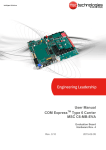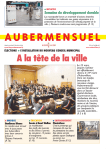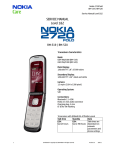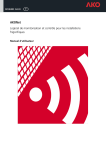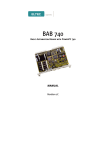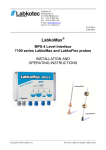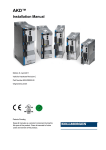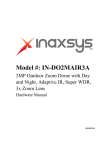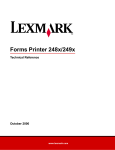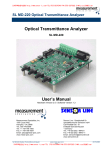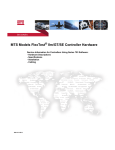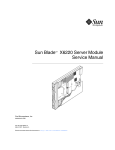Download BAB 750 - ELTEC Elektronik AG
Transcript
BAB 750 PowerPC 755 Based CompactPCI Board manual Revision 1B Revision Revision Changes Date / Name 1A First Edition, valid for Hardware revision 1A, 14.12.00 GM 1B Disclaimer new 08.11.06 hh DISCLAIMER Copyright © 2006 ELTEC Elektronik AG. The information, data, and figures in this document including respective references have been verified and found to be legitimate. In particular in the event of error they may, therefore, be changed at any time without prior notice. The complete risk inherent in the utilization of this document or in the results of its utilization shall be with the user; to this end, ELTEC Elektronik AG shall not accept any liability. Regardless of the applicability of respective copyrights, no portion of this document shall be copied, forwarded or stored in a data reception system or entered into such systems without the express prior written consent of ELTEC Elektronik AG, regardless of how such acts are performed and what system is used (electronic, mechanic, photocopying, recording, etc.). All product and company names are registered trademarks of the respective companies. Our General Business, Delivery, Offer, and Payment Terms and Conditions shall otherwise apply. Federal communications commission statement Þ This device complies with FCC Rules Part 15. Operation is subject to the following two conditions: Þ This device may not cause harmful interference, and Þ This device must accept any interference received including interference that may cause undesired operation. Þ This equipment has been tested and found to comply with the limits for a Class B digital device, pursuant to Part 15 of the FCC Rules. These limits are designed to provide reasonable protection against harmful interference in a residential installation. This equipment generates, uses and can radiate radio frequency energy and, if not installed and used in accordance with Þ Þ Þ Þ Þ manufacturer’s instructions, may cause harmful interference to radio communications. However, there is no guarantee that interference will not occur in a particular installation. If this equipment does cause harmful interference to radio or television reception, which can be determined by turning the equipment off and on, the user is encouraged to try correct the interference by one or more of the following measures: Reorient or relocate the receiving antenna. Increase the separation between the equipment and receiver. Connect the equipment to an outlet on a circuit different from that to which the receiver is connected. Consult the dealer or an experienced radio/TV technician for help. The us of shielded cables for connection of the monitor to the graphics card is required to assure compliance with FCC regulations. Changes or modifications to this unit not expressly approved by the party responsible for compliance could void the user’s authority to operate this equipment. Canadian department of communications statement Þ This digital apparatus does not exceed the Class B limits for radio noise emissions from digital apparatus set out in the Radio Interference Regulations of the Canadian Department of Communications. Þ This class B digital apparatus complies with Canadian ICES-003 SAFETY INFORMATION Electrical safety Þ To prevent electrical shock hazard, disconnect the power cable from the electrical outlet before reloading the system. Þ When adding or removing devices to or from the system, ensure that the power cables for the devices are unplugged before the signal cables are connected. If possible, disconnect all power cables from the existing system before you add device. Þ Before connecting or removing signals cables from motherboard, ensure that all power cables are unplugged. Þ Make sure that your power supply is set to the correct voltage in your area. If you are not sure about the voltage of the electrical outlet you are using, contact your local power company. Þ If the power supply is broken, do not try to fix it by yourself. Contact a qualified service technician or your retailer. Operation safety Þ Before installing the motherboard and adding devices on it, carefully read the manuals that came with the package. Þ Before using the product, make sure all cables are correctly connected and the power cables are not damaged. If you detect any damage, contact your dealer immediately. Þ To avoid short circuits, keep paper clips, screws, and staples away from connectors, slots sockets and circuitry. Þ Avoid dust, humidity, and temperature extremes. Do not place the product in any area where it may become wet. Þ Place the product on a stable surface. Þ If you encounter technical problems with the product, contact a qualified service technician or your retailer. EMC Rules This unit has to be installed in a shielded housing. If not installed in a properly shielded enclosure, and used in accordance with the instruction manual, this product may cause radio interference in which case the user may be required to take adequate measures at his or her own expense. IMPROTANT INFORMATION This product is not an end user product. It was developed and manufactured for further processing by trained personnel. RECYCLING Please recycle packaging environmentally friendly: Packaging materials are recyclable. Please do not dispose packaging into domestic waste but recycle it. Please recycle old or redundant devices environmentally friendly: Old devices contain valuable recyclable materials that should be reutilized. Therefore please dispose old devices at collection points which are suitable. User’s Manual Table of Contents Table of Contents 1 Specification...................................................................1—1 1.1 Main Features ...............................................................1—1 1.2 Specification Details......................................................1—2 1.2.1 CPU Kernel ................................................................1—2 1.2.2 Flash Memory ............................................................1—2 1.2.3 PCI Devices ...............................................................1—2 1.2.4 CompactPCI Interface ...............................................1—3 1.2.5 PMC ...........................................................................1—3 1.2.6 Mechanical.................................................................1—3 1.2.7 I/O ..............................................................................1—3 1.2.8 Compatibility ..............................................................1—4 1.2.9 Related Documents ...................................................1—4 2 Installation ......................................................................2—1 2.1 Frontpanel I/O ...............................................................2—1 2.2 Backpanel I/O ...............................................................2—2 2.2.1 CompactPCI Installation ............................................2—3 2.2.2 What‘s needed for Installation ...................................2—3 2.2.3 SODIMM Installation ..................................................2—4 BAB 750 I Table of Contents User’s Manual 2.2.4 Activity LEDs..............................................................2—5 3 Connector Assignments ...............................................3—1 3.1 Onboard Connectors.....................................................3—2 3.1.1 Keyboard / Mouse Connector ....................................3—2 3.1.2 Ethernet Connector....................................................3—3 3.1.3 Serial Ports 1 and 2 Connector..................................3—3 3.1.4 Parallel I/O Connector ...............................................3—4 3.1.5 CompactPCI Connectors ...........................................3—5 3.2 Transition board ..........................................................3—10 3.2.1 Additional Input/Output ............................................3—11 3.2.2 Floppy ......................................................................3—12 3.2.3 IDE ...........................................................................3—13 3.2.4 SCSI.........................................................................3—14 3.2.5 Serial (COM2) ..........................................................3—16 3.3 PMC-Carrier (PMCC)..................................................3—17 3.3.1 PMC Slots ................................................................3—18 3.3.2 CompactPCI.............................................................3—21 4 Board Parameters ..........................................................4—1 4.1 Host Bus .......................................................................4—1 II BAB 750 User’s Manual Table of Contents 4.2 CompactPCI..................................................................4—1 4.3 PCI Local Bus ...............................................................4—2 4.4 Network .........................................................................4—2 4.5 SCSI..............................................................................4—3 4.6 Serial I/O .......................................................................4—3 4.7 Keyboard:......................................................................4—3 4.8 Mouse ...........................................................................4—3 4.9 Parallel I/O ....................................................................4—4 4.10 MTBF Values ..............................................................4—4 4.11 Environmental Conditions ...........................................4—4 4.12 Maximum Operating Humidity: ...................................4—5 4.13 Power Requirements ..................................................4—5 5 Jumpers ..........................................................................5—1 5.1 Onboard Jumpers .........................................................5—1 5.1.1 User-settable Jumpers...............................................5—2 5.1.2 SCSI-Termination ......................................................5—3 6 Booting ...........................................................................6—1 6.1 Printout of Boot Screen.................................................6—1 7 Appendix.........................................................................7—1 BAB 750 III Table of Contents User’s Manual 7.1 Description of On-board Devices..................................7—1 7.1.1 Interrupt Controller .....................................................7—2 7.1.2 SRAM/RTC ................................................................7—3 7.1.3 GPIO Use...................................................................7—4 7.1.4 Super-I/O Power-on Strappings.................................7—5 7.1.5 I/O Address Map ........................................................7—6 7.1.6 Memory Address Map................................................7—7 7.1.7 PCI IDSEL..................................................................7—8 7.2 Factory Settable Jumpers.............................................7—9 IV BAB 750 User’s Manual Table of Contents BAB 750 V Table of Contents User’s Manual List of Tables Table 1: Activity LEDs.........................................................2—5 Table 2: Keyboard (6-pin miniature circular connector)......3—2 Table 3: Ethernet (8-pin telephone jack connector)............3—3 Table 4: COM1, COM2 (9-pin min-D connector) ................3—3 Table 5: Parallel I/O Connector ..........................................3—4 Table 6:CompactPCI Connector P1 ...................................3—5 Table 7: CompactPCI Connector P2 ..................................3—6 Table 8: CompactPCI Connector P4 ..................................3—7 Table 9: CompactPCI Connector P5 ..................................3—8 Table 10: Board-to-Board Connector..................................3—9 Table 11: Pinout additional Input/Output (X405) ..............3—11 Table 12: Pinout Floppy Connector (X401) ......................3—12 Table 13: Pinout IDE Connector (X403) ...........................3—13 Table 14: Pinout SCSI Connector 8 bit (X402) .................3—14 Table 15: Pinout SCSI Connector 16 bit (X404) ...............3—15 Table 16: Pinout COM2 ....................................................3—16 Table 17: Pinout PMC Connector (X301, X303, X305) ....3—18 Table 18: Pinout PMC Connector (X302, X304, X306) ....3—19 VI BAB 750 User’s Manual Table of Contents Table 19: Pinout PMC Connector (X401, X402, X403) ....3—20 Table 20: Pinout PMCC CompactPCI Connector P1 .......3—21 Table 21: Pinout PMCC CompactPCI Connector P3 .......3—22 Table 22: Pinout PMCC CompactPCI Connector P4 .......3—23 Table 23: Boot ROM Select (J114).....................................5—2 Table 24: Jumper J1601-J1603 ..........................................5—3 Table 25: Interrupt...............................................................7—3 Table 26: SRAM/RTC Address Assignment .......................7—3 Table 27: GPIO Usage........................................................7—4 Table 28: Super-I/O Wake Up Configuration: .....................7—5 Table 29: I/O Address Map .................................................7—6 Table 30: Memory Address Map (default used by VxWorks)..................................7—7 Table 31: IDSEL Connection .............................................7—8 Table 32: CPU PLL Configuration (J103...J106) ...............7—9 Table 33: System Clock (J111, J112, J113) ......................7—9 Table 34: MPC106 PLL Configuration (J110...J107).......7—10 Table 35: Hardware Debugger Configuration (J1301).....7—10 Table 36: Revision EEPROM Write Protection (J1302) ..7—10 BAB 750 VII Table of Contents User’s Manual List of Figures Figure 1: Block Diagram .....................................................1—5 Figure 2: Frontpanel I/O......................................................2—1 Figure 3: Connectors ..........................................................3—1 Figure 4: Transition board.................................................3—10 Figure 5: Additional Input/Output ......................................3—11 Figure 6: PMC-Carrier.......................................................3—17 Figure 7: Parts Side Jumpers .............................................5—1 Figure 8: Solder Side Jumpers ...........................................5—2 Figure 9: BAB 750 Interrupt Diagram .................................7—2 VIII BAB 750 Specification Specification User’s Manual 1 Specification Main Features • CompactPCI board with up to four PMC daughter card slots One on-board and three on a optional PMC carrier board (PMCC). Two slots required with PMC carrier board. • PowerPC CPU 755 with 300 MHz. • RAM: 8..128 MB (64-bit SODIMM) SDRAM (66/83 MHz, CL=2). • Cache: 1MB on-board. • PCI host bridge: Motorola MPC106. • PCI-ISA-Bridge: W83C553. • Intel 21152 PCI-to-PCI bridge to compactPCI bus. • Flash Eprom: 2 + 0,5 MB onboard, Flash programmable, byte access implemented in hardware. • Network interface: Ethernet using DEC21143 (10/100 Mbps) with PCI-DMA, 10BaseT connector at front panel. • Serial asynchronous: 2 * RS232 with PC97307. • Real-time clock: MK48T59 • IDE • Floppy • SCSI (optional): 53C875 BAB 750 1—1 Specification User’s Manual Specification Specification Detai ls 1.2.1 CPU Kernel The CPU kernel consists of the PowerPC 755 CPU with a clock rate of 300 MHz and host bus clock of 66/83 MHz. The CPU contains two parallel 32-bit integer execution units with an additional floating point unit for 8 SPECint95 and 6.2 SPECfp95 at 200 MHz. It has an external second-level cache running at 150 MHz. Memory is controlled by the host bridge MPC106 which contains the bridge between host bus and on-board PCI itself as well as the memory interface for EDO or SDRAM modules in SODIMM format (144-pin SODIMM module; 64-bit data bus). Memory size can be anywhere between 8 and 128 MB, depending on the DIMM modules used. 1.2.2 Flash Memory Up to 2 MB of user flash memory are supplied for storing usergenerated programs. Thus, diskless systems can be built. 1.2.3 PCI Devices The board-internal PCI bus is used for all I/O devices as well as the PCI-to-cPCI bridge. The PCI bus is of the master/slave type, capable of DMA transfers as source and target. A single-size PMC slot allows for interfacing, e.g. using a VGA display adapter PMC module or a frame grabber interface. Due to the bus-master DMA capabilities of the PMC implementation of the PCI standard, frame grabber can be implemented efficiently without frame buffers. A optional PMC carrier board allows additional three PMC modules. 1—2 BAB 750 Specification An Ethernet controller for either 10 Mbps or 100 Mbps Ethernet with PCI DMA capabilities is provided on-board. Front panel interface is 10/100BaseT. A optional ultra wide SCSI controller (53C875) allows transfer rates of up to 40Mb/s. The last interface on the local PCI bus is the ISA bridge (Winbond W83C553), interfacing to the internal ISA bus with additional onboard components. Additionally, there are the standard PC components real-time clock, watchdog, keyboard controller, dual serial I/O, floppy controller, IDE controller, and parallel controller. 1.2.4 CompactPCI Interface A Intel 51152 32-bit PCI-to-PCI bridge is used to connect to the compactPCI bus. The BAB 750 supplies system slot capabilities for four other compactPCI boards. 1.2.5 PMC A PCI extension card for PMC boards is provided. A PMC module carrier board (PMCC) can be installed to provide three PMC module slots. The PMC connectors are buffered with an additional 32-bit PCI-PCI brdge device, located on the carrier board. 1.2.6 Mechanical The board format is double Eurocard (6HU). If the optional PMC carrier is used the BAB 750 requires two slots. 1.2.7 I/O 16-bit SCSI, floppy, IDE, keyboard, mouse, COM2, and speaker are routed over the compactPCI P5 connector. Additionally printer and PMC I/O is connected to compactPCI P4. BAB 750 1—3 Specification User’s Manual Specification User’s Manual Specification On the front panel the Ethernet 10BaseT connector is located as well as the separate front panel for PMC I/O signals. The keyboard/mouse connector and two serial RS232 channel are also routed to the front panel. 1.2.8 Compatibility The BAB 750 has been designed to be software-compatible to the PowerPC reference platform (“Yellowknife”) as much as possible. 1.2.9 Related Documents PowerPC 750 Programmer's Reference: This is the CPU manufacturer's description of the PowerPC itself and the assembly language command set. 1—4 BAB 750 Specification Specification User’s Manual PowerPC Risc Microprocessor (MPC755, MPC7400) Processor Bus 66MHz (83MHz)/64-Bit PCI-/Memory Contr. (MPC106) PCI Bus L2 Cache Memory (SODIMM Socket) 33MHz/32-Bit PCI/PMC Slot PCI/PMC Extension Card PCI to cPCI Bridge (Intel 21152) cPCI Bus Ethernet Controller (DEC21143) Ethernet Interface SCSI Controller (SYM53C875) SCSI Interface PCI to ISA Bridge (W83C553) IDE Interface ISA Bus Real-Time Clock (MK48T59) Super I/O Controller (PC97307) Serial #1/2, Parallel PS2 Mouse, Keyboard (Floppy) 2 I C Bus Flash-EPROM (512KB Boot) (2MB User) EEPROM (Config. Info) Figure 1: Block Diagram BAB 750 1—5 Specification User’s Manual Specification 1—6 BAB 750 User’s Manual Installation 2 Installation RUN Frontpanel I/O HDD LINK • CPU Bus activity: "RUN" LED green • Harddisk activity: "HDD" LED yellow • Ethernet Link Status: "LINK" LED yellow/green (10 / 100 MBit) • Ethernet activity: "ACT" LED yellow • Reset: "RES" Trigger • Keyb./Mouse: "KEY" Mini-DIN • Serial #2: "COM2" Sub-D 9-pin • Serial #1 "COM1" Sub-D 9-pin • Ethernet: "100Tx" RJ45 • PMC Slot: "PMC" Installation ACT RES KEY COM2 COM1 100Tx Figure 2: Frontpanel I/O PMC BAB 750 2—1 Installation User’s Manual Backpanel I/O • Keyboard / Mouse • Floppy Disk Installation • IDE • SCSI • COM2 • Parallel 2—2 BAB 750 User’s Manual Installation 2—3 WARNING: The springs that hold the CPU heat sink violate the mechanical compactPCI specification. Make sure that the springs don’t touch other components that are installed adjecend of the BAB 750. WARNING: Due to the power dissipation of the MPC755 CPU it is not recommended to operate the BAB 750 without forced air cooling. The BAB 750 uses two compactPCI slots, when used with the PMCC carrier board. Since the two boards (BAB 750 and PMCC) have an internal connection, be sure to install respectively remove the two-board package carefully and simultaneously! 2.2.2 What‘s needed for Ins tallation The BAB 750 must be installed into the system slot of a cPCI rack. A terminal (or a PC with a terminal emulator program), set to 9600 baud, 8 bit, no parity, is needed to check boot messages and to change boot settings (connected to COM1). A SCSI hard disk can be attached via an transition board if the operating system is booted from disk; if it is booted from Ethernet, this network connection is needed. BAB 750 2—3 Installation 2.2.1 CompactPCI Installati on Installation User’s Manual 2.2.3 SODIMM Installation Installation All 144-pin SODIMMs up to 128 MByte that fit into the socket can be used with the BAB 750. The firmware reads the type and size of the SODIMM from the SPD (Serial Presence Detect) EEPROM installed on the memory module. However there are some restrictions and recommendations: • SDRAMs should be 100 MHz or faster. They must be able to operate with CL = 2 at 83 MHz. • FPMODE or EDO RAMs should be 60 ns or faster. • Due to performance reasons the use of SDRAM is strongly recommended (50% advantage). After reset the firmware tests the memory modules. If the test fails or the firmware reports the wrong size the module may not be suitable for the BAB 750. 2—4 BAB 750 User’s Manual Installation 2—5 2.2.4 Activity LEDs Installation There are four activity LEDs on the front panel of the BAB 750. The LEDs have a pulse stretcher to make short pulses visible. Table 1: Activity LEDs LED RUN DISK LNK Color Green Yellow Green/Yellow ACT Yellow Description CPU data bus in usage access to IDE or SCSI bus green = 100 Mbit link pulses present yellow = 10 Mbit link pulses present network activity BAB 750 2—5 Installation User’s Manual Installation 2—6 BAB 750 User’s Manual Connector Assignments 3 Connector Ass ignments Please check the connector assignments before making any connections! X1901 X2003 X1801 X1802 X1103 X2004 X2002 Hex Switch X1301 Connector Assignments X2001 X1701 X701 X1101 X1105 X1104 X2101 Figure 3: Connectors BAB 750 3—1 Connector Assignments User’s Manual Onboard Connecto rs 3.1.1 Keyboard / Mouse Con nector Table 2: Keyboard (6-pin miniature circular connector) Connector Assignments Pin 1 2 3 4 5 6 3—2 Signal KBDATA MDATA GND +5V KBCLK MCLK Front View 6 5 4 3 2 BAB 750 1 User’s Manual Connector Assignments 3.1.2 Ethernet Connector Table 3: Ethernet (8-pin telephone jack connector) 1 Signal TXD+ TXDRXD+ nc nc RXDnc nc 8 Front View Connector Assignments Pin 1 2 3 4 5 6 7 8 3.1.3 Serial Ports 1 and 2 C onnector Table 4: COM1, COM2 (9-pin min-D connector) Pin 1 2 3 4 5 6 7 8 9 Signal DCD RXD TXD DTR GND DSR RTS CTS RI Front View Pin 1 BAB 750 3—3 Connector Assignments User’s Manual 3.1.4 Parallel I/O Connecto r Table 5: Parallel I/O Connector Connector Assignments Pin 1 2 3 4 5 6 7 8 9 10 11 12 13 14 15 16 17 18 19 20 21 22 23 24 25 26 3—4 Signal /P_STB /P_AFD P_PD(0) /P_ERR P_PD(1) /P_INIT P_PD(2) /P_SLIN P_PD(3) GND P_PD(4) GND P_PD(5) GND P_PD(6) GND P_PD(7) GND /P_ACK GND /P_BUSY GND P_PE GND P_SLCT GND Top View 1 25 BAB 750 2 26 User’s Manual Connector Assignments 3.1.5 CompactPCI Connecto rs The CompactPCI connectors P1, P2, P4 and P5 provide the connection to the CompactPCI backplane. Pin 1 2 3 4 5 6 7 8 9 10 11 12 13 14 15 16 17 18 19 20 21 22 23 24 25 Row A VCC_IN reserved cPCI_/PIRQA reserved reserved S_REQ0# cPCI_AD(30) cPCI_AD(26) cPCI_C_/BE(3) cPCI_AD(21) cPCI_AD(18) KEY KEY KEY reserved cPCI_/DEVSEL reserved cPCI_/SERR reserved cPCI_AD(12) reserved cPCI_AD(7) reserved cPCI_AD(1) VCC_IN Row B -12V VCC_IN cPCI_/PIRQB cPCI_/HEALTHY reserved GND cPCI_AD(29) GND GND GND cPCI_AD(17) KEY KEY KEY cPCI_/FRAME GND reserved GND cPCI_AD(15) GND cPCI_AD(9) GND cPCI_AD(4) VCC_IN cPCI_/REQ64 Row C reserved reserved cPCI_/PIRQC V_I/O cPCI_/PCIRST reserved cPCI_AD(28) V_I/O cPCI_AD(23) reserved cPCI_AD(16) KEY KEY KEY cPCI_/IRDY V_I/O reserved reserved cPCI_AD(14) V_I/O cPCI_AD(8) reserved cPCI_AD(3) V_I/O cPCI_/ENUM Row D +12V reserved VCC_IN reserved GND S_CLK0# GND cPCI_AD(25) GND cPCI_AD(20) GND KEY KEY KEY GND cPCI_/STOP GND cPCI_PAR GND cPCI_AD(11) reserved cPCI_AD(6) VCC_IN cPCI_AD(0) reserved BAB 750 Row E VCC_IN reserved cPCI_/PIRQD reserved S_GNT0# cPCI_AD(31) cPCI_AD(27) cPCI_AD(24) cPCI_AD(22) cPCI_AD(19) cPCI_C_/BE(2) KEY KEY KEY cPCI_/TRDY cPCI_/LOCK cPCI_/PERR cPCI_C_/BE(1) cPCI_AD(13) cPCI_AD(10) cPCI_C_/BE(0) cPCI_AD(5) cPCI_AD(2) cPCI_/ACK64 VCC_IN Row F GND GND GND GND GND GND GND GND GND GND GND GND GND GND GND GND GND GND GND GND GND GND GND GND GND 3—5 Connector Assignments Table 6: CompactPCI Connector P1 Connector Assignments User’s Manual Table 7: CompactPCI Connector P2 Connector Assignments Pin 1 2 3 4 5 6 7 8 9 10 11 12 13 14 15 16 17 18 19 20 21 22 3—6 Row A S_CLK1# S_CLK2# reserved V_I/O cPCI_C_BE(5) cPCI_AD(63) cPCI_AD(59) cPCI_AD(56) cPCI_AD(52) cPCI_AD(49) cPCI_AD(45) cPCI_AD(42) cPCI_AD(38) cPCI_AD(35) reserved reserved reserved reserved GND reserved reserved reserved Row B GND S_CLK3# GND reserved GND cPCI_AD(62) GND cPCI_AD(55) GND cPCI_AD(48) GND cPCI_AD(41) GND cPCI_AD(34) GND reserved GND reserved GND GND GND reserved BAB 750 Row C S_REQ1# reserved S_GNT3# cPCI_C_BE(7) V_I/O cPCI_AD(61) V_I/O cPCI_AD(54) V_I/O cPCI_AD(47) V_I/O cPCI_AD(40) V_I/O cPCI_AD(33) cPCI_/FAL cPCI_/DEG cPCI_/PRST reserved reserved reserved reserved reserved Row D S_GNT1# S_GNT2# reserved GND cPCI_C_BE(4) GND cPCI_AD(58) GND cPCI_AD(51) GND cPCI_AD(44) GND cPCI_AD(37) GND reserved GND reserved GND reserved GND reserved reserved Row E S_REQ2# S_REQ3# reserved cPCI_C_BE(6) CPCI_PAR64 cPCI_AD(60) cPCI_AD(57) cPCI_AD(53) cPCI_AD(50) cPCI_AD(46) cPCI_AD(43) cPCI_AD(39) cPCI_AD(36) cPCI_AD(32) reserved reserved reserved reserved reserved reserved reserved reserved Row F GND GND GND GND GND GND GND GND GND GND GND GND GND GND GND GND GND GND GND GND GND GND User’s Manual Connector Assignments Pin 1 2 3 4 5 6 7 8 9 10 11 12 13 14 15 16 17 18 19 20 21 22 23 24 25 Row A /P_STB P_PD(4) /P_BUSY /P_INIT reserved reserved reserved reserved GND V_IO PMC_IO60 KEY KEY KEY PMC_IO55 PMC_IO50 PMC_IO45 PMC_IO40 PMC_IO35 PMC_IO30 PMC_IO25 PMC_IO20 PMC_IO15 PMC_IO10 PMC_IO5 PMC I/O, Parallel Port Row B Row C Row D P_PD(0) P_PD(1) P_PD(2) P_PD(5) P_PD(6) P_PD(7) P_PE P_SLCT /P_AFD /P_SLIN reserved reserved reserved reserved reserved reserved reserved reserved reserved reserved reserved reserved reserved reserved GND GND GND PMC_IO64 PMC_IO63 PMC_IO62 PMC_IO59 PMC_IO58 PMC_IO57 KEY KEY KEY KEY KEY KEY KEY KEY KEY PMC_IO54 PMC_IO53 PMC_IO52 PMC_IO49 PMC_IO48 PMC_IO47 PMC_IO44 PMC_IO43 PMC_IO42 PMC_IO39 PMC_IO38 PMC_IO37 PMC_IO34 PMC_IO33 PMC_IO32 PMC_IO29 PMC_IO28 PMC_IO27 PMC_IO24 PMC_IO23 PMC_IO22 PMC_IO19 PMC_IO18 PMC_IO17 PMC_IO14 PMC_IO13 PMC_IO12 PMC_IO9 PMC_IO8 PMC_IO7 PMC_IO4 PMC_IO3 PMC_IO2 BAB 750 Row E P_PD(3) /P_ACK /P_ERR reserved reserved reserved reserved reserved GND PMC_IO61 PMC_IO56 KEY KEY KEY PMC_IO51 PMC_IO46 PMC_IO41 PMC_IO36 PMC_IO31 PMC_IO26 PMC_IO21 PMC_IO16 PMC_IO11 PMC_IO6 PMC_IO1 Row F GND GND GND GND GND GND GND GND GND GND GND GND GND GND GND GND GND GND GND GND GND GND GND GND GND 3—7 Connector Assignments Table 8: CompactPCI Connector P4 Connector Assignments User’s Manual Table 9: CompactPCI Connector P5 Connector Assignments Pin 1 2 3 4 5 6 7 8 9 10 11 12 13 14 15 16 17 18 19 20 21 22 3—8 Wide SCSI, IDE, Floppy, Keyboard, Mouse, COM2, Speaker Row A Row B Row C Row D Row E /SCSI_DP0 /SCSI_D11 /SCSI_IO FD_DRDEN0 FD_DRDEN1 /SCSI_D7 /SCSI_D10 /SCSI_REQ /FD_INDEX /FD_MTR0 /SCSI_D6 /SCSI_D9 /SCSI_C/D /FD_DS0 /FD_DIR /SCSI_D5 /SCSI_D8 /SCSI_SEL /FD_STEP /FD_WDATA GND /SCSI_DP1 /SCSI_MSG /FD_WGATE /FD_TRK0 /SCSI_D4 GND /SCSI_RST /FD_WRTPRT /FD_RDATA /SCSI_D3 /SCSI_D15 GND /FD_HDSEL /FD_DSKCHG /SCSI_D2 /SCSI_D14 /SCSI_ACK GND GND /SCSI_D1 /SCSI_D13 /SCSI_BSY COM2_DCD COM2_RXD /SCSI_D0 /SCSI_D12 /SCSI_ATN COM2_TXD COM2_DTR GND GND SCSI_TPWR COM2_RTS COM2_DSR IDE_A2 IDE_A1 IDE_A0 COM2_RI COM2_CTS IDE_D8 /IDE_RST /IDE_ACT 12V (1) -12V (1) IDE_D9 IDE_D0 /IDE_IOW reserved reserved IDE_D10 IDE_D1 /IDE_IOR reserved reserved GND IDE_D2 IDE_IORDY reserved reserved IDE_D11 GND IDE_IRQ reserved reserved IDE_D12 IDE_D3 GND 5V sUSB_OC IDE_D13 IDE_D4 IDE_DREQ KB_CLK sUSB_PLUS IDE_D14 IDE_D5 /IDE_DACK KB_DATA sUSB_MINUS IDE_D15 IDE_D6 /IDE_CS1 MS_CLK 5V /IDE_IOCS16 IDE_D7 /IDE_CS3 MS_DATA SPEAKER BAB 750 Row F GND GND GND GND GND GND GND GND GND GND GND GND GND GND GND GND GND GND GND GND GND GND User’s Manual Connector Assignments Pin 1 2 3 4 5 6 7 8 9 10 11 12 13 14 15 16 17 18 19 20 21 22 23 24 25 Row Z GND GND GND GND GND GND GND GND GND GND GND GND GND GND GND GND GND GND GND GND GND GND GND GND GND Row A AD0 AD5 GND AD10 AD15 AD20 AD25 GND AD30 AD35 AD40 AD45 GND AD50 AD55 AD60 C_/BE1 GND CLK0 /INTD /REQ1 /INTD GND /IRDY TDO Row B AD1 AD6 AD11 GND AD16 AD21 AD26 AD31 GND AD36 AD41 AD46 AD51 GND AD56 AD61 C_/BE2 C_/BE7 GND C_/BE6 /GNT1 /SERR /DEVSEL GND TDI Row C AD2 AD7 AD12 AD17 GND AD22 AD27 AD32 AD37 GND AD42 AD47 AD52 AD57 GND AD62 C_/BE3 /INTA IDSEL1 GND /REQ64 PAR /STOP /RST /TRST Row D AD3 AD8 AD13 AD18 AD23 GND AD28 AD33 AD38 AD43 GND AD48 AD53 AD58 AD63 GND C_/BE4 /INTB /REQ0 /ACK64 GND IDSEL0 /LOCK /PERR TCK BAB 750 Row E AD4 AD9 AD14 AD19 AD24 AD29 GND AD34 AD39 AD44 AD49 GND AD54 AD59 C_/BE0 C_/BE5 GND /INTC /GNT0 PAR64 CLK1 GND /FRAME /TRDY TMS Row F GND GND GND GND GND GND GND GND GND GND GND GND GND GND GND GND GND GND GND GND GND GND GND GND GND 3—9 Connector Assignments Table 10: Board-to-Board Connector Connector Assignments User’s Manual Transition board An IBM compatible floppy disk drive, an IDE harddisk, a SCSI harddisk (8 Bit, 16 Bit), COM2, and additional inputs/outputs may be connected to BAB 750 via a small transition board. This board has to be connected to the CompactPCI backplane. COM2 X203 J301 SCSI 16 Bit X404 SCSI 8 Bit X402 Flatp. X201 Connector Assignments IDE X403 Floppy X401 I/O X405 J201 J202 J203 X103 P5 X102 P3 Figure 4: Transition board 3—10 BAB 750 User’s Manual Connector Assignments 3.2.1 Additional Input/Outpu t This connector can be used to connect additional Inputs and Outputs. Keyboard Mouse Speaker Figure 5: Additional Input/Output Pin 1 3 5 7 9 11 13 15 17 19 Name Vcc /MSDAT /MSCLK res. res. res. res. Vcc GND res. Function Power Data from Mouse Clock for Mouse reserved reserved reserved reserved Power Power reserved Function Data from/to Keyboard Clock for Keyboard Power reserved reserved reserved Power Power Power Speaker Name /KBDAT /KBCLK GND res. res. res. Vcc GND GND SPKR Pin 2 4 6 8 10 12 14 16 18 20 3.2.1.1 Keyboard/Mouse The pins for the Keyboard/Mouse-Interface provide PS/2 compatible signals to connect standard PC-Hardware. 3.2.1.2 Loudspeaker These pins can be used to connect a loudspeaker. BAB 750 3—11 Connector Assignments Table 11: Pinout additional Input/Output (X405) Connector Assignments User’s Manual 3.2.2 Floppy The floppy cable is connected between floppy drive and the adapter connector. The power supply cable for the floppy drive must be connected directly to the power supply. Table 12: Pinout Floppy Connector (X401) Connector Assignments Pin 1 3 5 7 9 11 13 15 17 19 21 23 25 27 29 31 33 Name Gnd Gnd Gnd Gnd Gnd Gnd Gnd Gnd Gnd Gnd Gnd Gnd Gnd Gnd Gnd Gnd Gnd Name DRVDEN0 nc DRVDEN1 /INDEX /MTR0 nc nc MTR1 /DIR /STEP /WDATA /WGATE /TRK0 /WRTPRT /RDATA /HDSEL /DSKCHG Pin 2 4 6 8 10 12 14 16 18 20 22 24 26 28 30 32 34 The BAB 750 supports only one floppy drive. It must be conected in the same way as floppy drive A of a PC computer (i.e. at the crossed section of a standard PC floppy cable). 3—12 BAB 750 User’s Manual Connector Assignments 3.2.3 IDE Like the floppy disk drive an EIDE drive is connected with its flat cable to the adapter. The power supply cable of the EIDE device must be directly connected to the power supply. Up to two EIDE drives (harddisk, CD-ROM) can be connected. Cable length should not exceed 40 cm to avoid instable operation. Table 13: Pinout IDE Connector (X403) Name /RST D7 D6 D5 D4 D3 D2 D1 D0 GND REQ /IOW /IOR IORDY /ACK IRQ14 A1 A0 /CS1 /ACT Name GND D8 D9 D10 D11 D12 D13 D14 D15 nc GND GND GND nc GND nc nc A2 /CS3 GND Pin 2 4 6 8 10 12 14 16 18 20 22 24 26 28 30 32 34 36 38 40 BAB 750 Connector Assignments Pin 1 3 5 7 9 11 13 15 17 19 21 23 25 27 29 31 33 35 37 39 3—13 Connector Assignments User’s Manual 3.2.4 SCSI SCSI is only available on board versions with SCSI option. The SCSI cable is plugged into the appropriate connector on transition board. All SCSI devices must be cabled in a bus-like fashion, i.e. the cable goes from one device to the next one. The cable end must be terminated to ensure proper operation. An active terminator is recommended. Table 14: Pinout SCSI Connector 8 bit (X402) Connector Assignments Pin 1 3 5 7 9 11 13 15 17 19 21 23 25 27 29 31 33 35 37 39 41 43 45 47 49 3—14 Name GND GND GND GND GND GND GND GND GND GND GND GND nc GND GND GND GND GND GND GND GND GND GND GND GND Name D0 D1 D2 D3 D4 D5 D6 D7 PD0 GND GND GND TERMPWR GND GND /ATN GND /BSY /ACK /RST /MSG /SEL /C_D /REQ /I_O BAB 750 Pin 2 4 6 8 10 12 14 16 18 20 22 24 26 28 30 32 34 36 38 40 42 44 46 48 50 User’s Manual Connector Assignments Table 15: Pinout SCSI Connector 16 bit (X404) Name GND GND GND GND GND GND GND GND GND GND GND GND GND GND GND GND TERMPWR TERMPWR nc nc nc GND GND GND GND nc GND nc GND nc GND GND GND GND Name D12 D13 D14 D15 PD1 D0 D1 D2 D3 D4 D5 D6 D7 PD0 nc nc TERMPWR TERMPWR nc GND /ATN GND /BSY /ACK /RST /MSG /SEL /C_D /REQ /I_O D8 D9 D10 D11 Pin 2 4 6 8 10 12 14 16 18 20 22 24 26 28 30 32 34 36 38 40 42 44 46 48 50 52 54 56 58 60 62 64 66 68 BAB 750 Connector Assignments Pin 1 3 5 7 9 11 13 15 17 19 21 23 25 27 29 31 33 35 37 39 41 43 45 47 49 51 53 55 57 59 61 63 65 67 3—15 Connector Assignments User’s Manual 3.2.5 Serial (COM2) The BAB 750 supports two serial ports. COM1 and COM2 are located at the front panel (9-pin D). Additionally COM2 is routed via the transition board. Table 16: Pinout COM2 Connector Assignments Pin 1 2 3 4 5 6 7 8 9 3—16 Signal DCD1 RXD1 TXD1 DTR1 GND DSR1 RTS1 CTS1 RI1 Front View Pin 1 BAB 750 User’s Manual Connector Assignments PMC-Carrier (PMCC ) 1 1 X0405 P4 1 X0404 P3 X0202 P1 X0302 X0401 X0304 X0402 X0306 X0403 X0301 PMC-Slot 1 X0303 PMC-Slot 2 X0305 PMC-Slot 3 PCI2PCI Bridge Connector Assignments 32 bit X0101 Board-toBoard Figure 6: PMC-Carrier The PMC-Carrier board can be used to connect three PMC boards to the PCIbus of the BAB 750. It has to be plugged into Board-toBoard connector. The PMC-Modules are isolated from the lokal PCI bus via a Intel 21152 PCI-to-PCI bridge (32 bit). BAB 750 3—17 Connector Assignments User’s Manual 3.3.1 PMC Slots Table 17: Pinout PMC Connector (X301, X303, X305) Connector Assignments Pin 1 3 5 7 9 11 13 15 17 19 21 23 25 27 29 31 33 35 37 39 41 43 45 47 49 51 53 55 57 59 61 63 3—18 Name TCK GND /IRQB nc /IRQD GND PCICLK GND /PREQ 5V AD28 AD25 GND AD22 AD19 5V /FRAME GND /DEVSEL GND SDONE PAR 5V AD12 AD9 GND AD6 AD4 5V AD2 AD0 GND Name -12 V /IRQA /IRQC 5V nc nc GND /PGNT 5V AD31 AD27 GND /C_BE3 AD21 5V AD17 GND /IRDY 5V /PLOCK /SBO GND AD15 AD11 5V /C_BE0 AD5 GND AD3 AD1 5V /REQ64 Pin 2 4 6 8 10 12 14 16 18 20 22 24 26 28 30 32 34 36 38 40 42 44 46 48 50 52 54 56 58 60 62 64 BAB 750 User’s Manual Connector Assignments Table 18: Pinout PMC Connector (X302, X304, X306) Name 12 V TMS TDI GND nc BM1 /PCIRST 3.3 V nc AD30 GND AD24 IDSEL 3.3 V AD18 AD16 GND /TRDY GND /PERR 3.3 V /C_BE1 AD14 GND AD8 AD7 3.3 V nc nc GND /ACK64 GND Name /TRST TDO GND nc nc 3.3 V BM3 BM4 GND AD29 AD26 3.3 V AD23 AD20 GND /C_BE2 nc 3.3 V /STOP GND /SERR GND AD13 AD10 3.3 V nc nc GND nc nc 3.3 V nc Pin 2 4 6 8 10 12 14 16 18 20 22 24 26 28 30 32 34 36 38 40 42 44 46 48 50 52 54 56 58 60 62 64 Connector Assignments Pin 1 3 5 7 9 11 13 15 17 19 21 23 25 27 29 31 33 35 37 39 41 43 45 47 49 51 53 55 57 59 61 63 BAB 750 3—19 Connector Assignments User’s Manual Table 19: Pinout PMC Connector (X401, X402, X403) Connector Assignments Pin 1 3 5 7 9 11 13 15 17 19 21 23 25 27 29 31 33 35 37 39 41 43 45 47 49 51 53 55 57 59 61 63 3—20 Name IO01 IO03 IO05 IO07 IO09 IO11 IO13 IO15 IO17 IO19 IO21 IO23 IO25 IO27 IO29 IO31 IO33 IO35 IO37 IO39 IO41 IO43 IO45 IO47 IO49 IO51 IO53 IO55 IO57 IO59 IO61 IO63 Name IO02 IO04 IO06 IO08 IO00 IO12 IO14 IO16 IO18 IO10 IO22 IO24 IO26 IO28 IO20 IO32 IO34 IO36 IO38 IO30 IO42 IO44 IO46 IO48 IO40 IO52 IO54 IO56 IO58 IO50 IO62 IO64 Pin 2 4 6 8 10 12 14 16 18 20 22 24 26 28 30 32 34 36 38 40 42 44 46 48 50 52 54 56 58 60 62 64 BAB 750 User’s Manual Connector Assignments 3.3.2 CompactPCI The CompactPCI connectors P1, P2, P3 and P4 providing the connection to the CompactPCI backplane. Pin 1 2 3 4 5 6 7 8 9 10 11 12 13 14 15 16 17 18 19 20 21 22 23 24 25 Row A VCC_IN Nc Nc Nc Nc Nc Nc Nc Nc Nc Nc KEY KEY KEY 3,3 V Nc 3,3 V Nc 3,3 V Nc 3,3 V Nc 3,3 V Nc VCC_IN Row B -12V VCC_IN Nc Nc Nc GND Nc GND GND GND Nc KEY KEY KEY Nc GND Nc GND Nc GND Nc GND Nc VCC_IN Nc Row C nc Nc Nc Nc Nc 3,3 V Nc Nc Nc 3,3 V Nc KEY KEY KEY Nc Nc Nc 3,3 V Nc Nc Nc 3,3 V Nc Nc Nc Row D +12V Nc Nc Nc GND Nc GND Nc GND Nc GND KEY KEY KEY GND Nc GND Nc GND Nc Nc Nc Nc Nc Nc BAB 750 Row E Nc Nc Nc Nc Nc Nc Nc Nc Nc Nc Nc KEY KEY KEY Nc Nc Nc Nc Nc Nc Nc Nc Nc Nc VCC_IN Row F GND GND GND GND GND GND GND GND GND GND GND GND GND GND GND GND GND GND GND GND GND GND GND GND GND 3—21 Connector Assignments Table 20: Pinout PMCC CompactPCI Connector P1 Connector Assignments User’s Manual Table 21: Pinout PMCC CompactPCI Connector P3 Connector Assignments Pin 1 2 3 4 5 6 7 8 9 10 11 12 13 14 15 16 17 18 19 3—22 Row A V_IO PMC3_IO60 PMC3_IO55 PMC3_IO50 PMC3_IO45 PMC3_IO40 PMC3_IO35 PMC3_IO30 PMC3_IO25 PMC3_IO20 PMC3_IO15 PMC3_IO10 PMC3_IO5 3V3 V_IO PMC2_IO60 PMC2_IO55 PMC2_IO50 PMC2_IO45 Row B PMC3_IO64 PMC3_IO59 PMC3_IO54 PMC3_IO49 PMC3_IO44 PMC3_IO39 PMC3_IO34 PMC3_IO29 PMC3_IO24 PMC3_IO19 PMC3_IO14 PMC3_IO9 PMC3_IO4 3V3 PMC2_IO64 PMC2_IO59 PMC2_IO54 PMC2_IO49 PMC2_IO44 BAB 750 Row C PMC3_IO63 PMC3_IO58 PMC3_IO53 PMC3_IO48 PMC3_IO43 PMC3_IO38 PMC3_IO33 PMC3_IO28 PMC3_IO23 PMC3_IO18 PMC3_IO13 PMC3_IO8 PMC3_IO3 3V3 PMC2_IO63 PMC2_IO58 PMC2_IO53 PMC2_IO48 PMC2_IO43 Row D PMC3_IO62 PMC3_IO57 PMC3_IO52 PMC3_IO47 PMC3_IO42 PMC3_IO37 PMC3_IO32 PMC3_IO27 PMC3_IO22 PMC3_IO17 PMC3_IO12 PMC3_IO7 PMC3_IO2 5V PMC2_IO62 PMC2_IO57 PMC2_IO52 PMC2_IO47 PMC2_IO42 Row E PMC3_IO61 PMC3_IO56 PMC3_IO51 PMC3_IO46 PMC3_IO41 PMC3_IO36 PMC3_IO31 PMC3_IO26 PMC3_IO21 PMC3_IO16 PMC3_IO11 PMC3_IO6 PMC3_IO1 5V PMC2_IO61 PMC2_IO56 PMC2_IO51 PMC2_IO46 PMC2_IO41 User’s Manual Connector Assignments Table 22: Pinout PMCC CompactPCI Connector P4 Row A PMC2_IO40 PMC2_IO35 PMC2_IO30 PMC2_IO25 PMC2_IO20 PMC2_IO15 PMC2_IO10 PMC2_IO5 GND V_IO PMC1_IO60 KEY KEY KEY PMC1_IO55 PMC1_IO50 PMC1_IO45 PMC1_IO40 PMC1_IO35 PMC1_IO30 PMC1_IO25 PMC1_IO20 PMC1_IO15 PMC1_IO10 PMC1_IO5 Row B PMC2_IO39 PMC2_IO34 PMC2_IO29 PMC2_IO24 PMC2_IO19 PMC2_IO14 PMC2_IO9 PMC2_IO4 GND PMC1_IO64 PMC1_IO59 KEY KEY KEY PMC1_IO54 PMC1_IO49 PMC1_IO44 PMC1_IO39 PMC1_IO34 PMC1_IO29 PMC1_IO24 PMC1_IO19 PMC1_IO14 PMC1_IO9 PMC1_IO4 Row C PMC2_IO38 PMC2_IO33 PMC2_IO28 PMC2_IO23 PMC2_IO18 PMC2_IO13 PMC2_IO8 PMC2_IO3 GND PMC1_IO63 PMC1_IO58 KEY KEY KEY PMC1_IO53 PMC1_IO48 PMC1_IO43 PMC1_IO38 PMC1_IO33 PMC1_IO28 PMC1_IO23 PMC1_IO18 PMC1_IO13 PMC1_IO8 PMC1_IO3 Row D PMC2_IO37 PMC2_IO32 PMC2_IO27 PMC2_IO22 PMC2_IO17 PMC2_IO12 PMC2_IO7 PMC2_IO2 GND PMC1_IO62 PMC1_IO57 KEY KEY KEY PMC1_IO52 PMC1_IO47 PMC1_IO42 PMC1_IO37 PMC1_IO32 PMC1_IO27 PMC1_IO22 PMC1_IO17 PMC1_IO12 PMC1_IO7 PMC1_IO2 BAB 750 Row E PMC2_IO36 PMC2_IO31 PMC2_IO26 PMC2_IO21 PMC2_IO16 PMC2_IO11 PMC2_IO6 PMC2_IO1 GND PMC1_IO61 PMC1_IO56 KEY KEY KEY PMC1_IO51 PMC1_IO46 PMC1_IO41 PMC1_IO36 PMC1_IO31 PMC1_IO26 PMC1_IO21 PMC1_IO16 PMC1_IO11 PMC1_IO6 PMC1_IO1 Connector Assignments Pin 1 2 3 4 5 6 7 8 9 10 11 12 13 14 15 16 17 18 19 20 21 22 23 24 25 3—23 Connector Assignments Connector Assignments 3—24 BAB 750 User’s Manual User’s Manual Board Parameters 4 Board Paramet ers Host Bus 66 or 83 MHz CompactPCI System slot CompactPCI interface according to specification PICMG 2.0 (Rev. 3.0) from October 1, 1999. 32 bit Intel 21152 Bridge supports up to 4 periperal slots Board Parameters 32-bit I/O address range 32-bit memory-mapped I/O address range BAB 750 4—1 Board Parameters User’s Manual PCI Local Bus CPU to PCI Transfer Options: Write post buffer Max. 120 MB/s (peak) PCI to Memory Transfer Options: Max. 120 MB/s (peak) Clock Speed: 33.3 MHz IRQs Board Parameters Four PCI interrupts rerouted to selectable ISA interrupts Network 10BaseT/100BaseTx (twisted-pair) Transfer Speed: max. 10/100 Mbit/s 4—2 BAB 750 User’s Manual Board Parameters SCSI Ultra wide SCSI (8/16 bit) Transfer Speed: asynchronous transfer 5 MB/s synchronous transfer 20 MB/s (8-bit) synchronous transfer 40 MB/s (16-bit). Serial I/O 2 Channels: Board Parameters Full duplex, asynchronous 50 b/s - 115,2 KB/s RS232 level Keyboard: MF2/AT mode PS/2 mode Mouse PS/2 mode Serial mouse at channel 1 or channel 2 BAB 750 4—3 Board Parameters User’s Manual Parallel I/O Centronics bidirectional, unbuffered TTL Transfer Rate: max. 2 MB/s MTBF Values Includes one 64 Mbyte SODIMM. 23865 h (computed after MTL HDBK-217E) 319795 h (realistic value from industry standard experience) ESD Values: 2 kV (Human body method) Environmental Con ditions Board Parameters Storage Temperature: -40° C - +70° C (non condensing) Operating Temperature: 0° C - +50° C (1 m/s forced air cooling) 4—4 BAB 750 User’s Manual Board Parameters Maximum Operatin g Humidity: 85% relative Power Requiremen ts Total Power Requirements (without PCI extensions) 4.0 A max. 3.0 A typ. +5 VDC +/-5% 100 mA max. 30 mA typ. +12 VDC +/-10% 100 mA max. 10 mA typ. -12 VDC +/-10% Battery Board Parameters Type M4T28-BR12SH1 Approx. 8 years life time BAB 750 4—5 Board Parameters Board Parameters 4—6 BAB 750 User’s Manual User’s Manual Jumpers 5 Jumpers Onboard Jumpers X2003 X1901 X1801 X1802 X1103 J1301 J1601 J1602 J1603 X2004 X2001 System Clock J111 J112 J113 SCSI Term J114 J1201 J1302 COP UROM Boot Write EEPROM Enable BROM X1301 X2002 Hex Switch X1701 X701 X1101 X1105 X1104 X2101 Jumpers Figure 7: Parts Side Jumpers BAB 750 5—1 Jumpers User’s Manual J107 J108 J109 J110 MPC106 PLL J103 J104 J105 J106 CPU PLL Figure 8: Solder Side Jumpers 5.1.1 User-settable Jumpers Table 23: Boot ROM Select (J114) Jumpers J114 open Short 5—2 Description Boot from Boot-ROM (default) Boot from User-ROM, 1 MB usable BAB 750 User’s Manual Jumpers 5.1.2 SCSI-Termination Table 24: Jumper J1601-J1603 J1601 - Jumper J1602 1-2 1-2 J1603 1-2 2-3 - 1-2 - 1-2 1-2 1-2 1-2 2-3 - all others - - Function Jumpers Automatic Mode (default) Automatic LowByte Termination, Enable HighByte Termination Automatic LowByte Termination, Disable HighByte Termination Enable Termination Enable LowByte Termination, Disable HighByte Termination Disable Termination not allowed BAB 750 5—3 Jumpers User’s Manual Jumpers 5—4 BAB 750 User’s Manual Booting 6 Booting Printout of Boot Sc reen This chapter shows how the terminal screen looks like on a BAB 750 after power-on. *** ELTEC Elektronik, Mainz *** BAB-PPC Monitor Version 1.2/2 Init MPU/MSR/FPU/Segment registers. Init SuperIO (polled output on COM1). Activating 1st level cache .................... OK Setting MPC106 register ....................... OK Reading SPD of bank0/1 ........................ OK RAM-Type: SDRAM Reading SPD of bank2/3 .................... FAILED Activating 64 MByte. PowerPC 74x/75x Ver.0008 Rev.3202 at 292 / 83 MHz PCI devices on local bus ... No. VendorId DeviceId Device Class Sub-Class __________________________________________________ 00 1057 0002 Bridge device 00 0B 10AD 0565 Bridge device 01 0D 1000 000F Mass storage controller 00 0E 1011 0019 Network controller 00 13 1011 0024 Bridge device 04 Press any key to skip memory test : 65536 KByte Booting Due to the fact that no second SODIMM can be installed on the BAB 750 the failed read out of bank 2/3 is normal. Ths is no indication of a malfunction. BAB 750 6—1 Booting User’s Manual Booting 6—2 BAB 750 Appendix Appendix User’s Manual 7 Appendix Description of On-b oard Devices This chapter describes how the on-board devices are accessed by operating system drivers. When an operating system, such as OS-9 and VxWorks, is used, there should be no need to address these devices with user-written code. BAB 750 7—1 Appendix User’s Manual Appendix 7.1.1 Interrupt Controller PowerPC INT INT OUT W83C553 PCI INT A INT B INT C cPCI, PMCC, PMC INT D INT 9 RTC (MK48T59) cPCI, PMCC, SCSI INT 1; 3..12; 14; 15 Super I/O (PC97307) cPCI, Network cPCI, PMCC Figure 9: BAB 750 Interrupt Diagram This diagram shows how the on-board interrupt sources are connected to the interrupt controller, located in the W83C553 chip. This chip then prioritizes and drives the CPU interrupt input. The priority scheme used is shown below: 7—2 BAB 750 Appendix Appendix User’s Manual Table 25: Interrupt Priority 1 2 3 4 5 6 7 8 9 10 11 12 13 14 15 ISA IRQ INT 0 INT 1 INT 8 INT 9 INT10 INT 11 INT 12 INT 13 INT 14 INT 15 INT 3 INT 4 INT 5 INT 6 INT 7 PCI IRQ Source Timer 0 (Ticker) Keyboard INT A INT B PMC, cPCI, PMCC SCSI or IDE, cPCI, PMCC Mouse INT C INT D Ethernet, cPCI, PMCC cPCI, PMCC Serial #2 Serial #1 RTC (Watchdog) Floppy Parallel Port 7.1.2 SRAM/RTC A indirect addressing scheme is used to access the M48T59Y SRAM/RTC. To access the SRAM/RTC the desired address first must be written to I/O address $70 and $71. Then the data can be accessed via I/O address $76. The interrupt output of the M48T59Y is connected with the INT5 input of the interrupt controller. It may be used to generate periodic interrupts or watchdog interrupts. Table 26: SRAM/RTC Address Assignment I/O Address $070 $071 $076 Description SRAM/RTC LSB Address SRAM/RTC MSB Address SRAM/RTC Data BAB 750 7—3 Appendix User’s Manual Appendix 7.1.3 GPIO Use The GPIOs of the Super-I/O are used for the following purposes: Table 27: GPIO Usage Name GPIO10 GPIO11 GPIO12 GPIO13 GPIO14 GPIO15 GPIO16 GPIO17 Type I I/O O - GPIO20 GPIO21 GPIO22 GPIO23 GPIO24 GPIO25 GPIO26 GPIO27 O O I I I I Function not used CPU Bus Speed (0 = 83 MHz; 1 = 66MHz) reseved reseved reseved I2C Data for SPD of SODIMM, ELTEC Revision EEPROM I2C Clock for SPD of SODIMM, ELTEC Revision EEPROM not used cPCI Interrupt Routing bit 0* cPCI Interrupt Routing bit 1* not used not used HEX Switch LSB HEX Switch HEX Switch HEX Switch MSB * CompactPCI Interrupt Routing: bit 1 bit 0 (GPIO21) (GPIO20) 0 0 1 1 7—4 0 1 0 1 Function cPCI interrupts mapped to PCI interrupt D cPCI interrupts mapped to the corresponding PCI interrupt reserved reserved BAB 750 Appendix Appendix User’s Manual 7.1.4 Super-I/O Power-on S trappings The Super-I/O wakes up in the following configuration: Table 28: Super-I/O Wake Up Configuration: Pin CFG0 CFG1 CFG3,2 BADDR1,0 SELCS Configuration FDC, KBC and RTC inactive No X-Bus Data Buffer Clock source is 24 MHz fed via X1 Pin PnP Motherboard, Wake in Config state, Index 015Ch /CS0 on /CS0 pin BAB 750 7—5 Appendix User’s Manual Appendix 7.1.5 I/O Address Map After initialization the following I/O address map becomes effective: Table 29: I/O Address Map I/O Address $000-$00F $020-$021 $040-$043 $060 $061 $064 $070 $071 $076 $078-$07B $081-$082 $087 $089-$08B $092 $0A0-$0A1 $0C0-$0DE $15C $15D $1F0-$1F7 $220-$223 $224-$227 $278-$27F $2F8-$2FF $3F0-$3F7 $3F8-$3FF $3C2-$3C9 $3CE-$3CF $3D4-$3D5 $4D0-$4D1 7—6 Device W83C553F W83C553F W83C553F PC97307 W83C553F PC97307 M48T59Y M48T59Y M48T59Y W83C553F W83C553F W83C553F W83C553F W83C553F W83C553F W83C553F PC97307 PC97307 W83C553F PC97307 PC97307 PC97307 PC97307 PC97307 PC97307 SM710 SM710 SM710 W83C553F Description DMA Controller 1 Interrupt Controller 1 Counter/Timer Keyboard Data Port B Keyboard Control SRAM/RTC LSB Address SRAM/RTC MSB Address SRAM/RTC Data BIOS Timer DMA Page DMA Page DMA Page Port 92 Interrupt Controller 2 DMA Controller 2 SuperI/O Index SuperI/O Data IDE Controller GPIO Port 1 GPIO Port 2 Parallel Port COM2 Floppy/IDE Controller COM1 VGA Controller VGA Controller VGA Controller Interrupt Mode BAB 750 Appendix 7.1.6 Memory Address Map The BAB 750 uses address map B (CHRP) of the MPC106. After initialization the following address map becomes effective: Table 30: Memory Address Map (default used by VxWorks) CPU Address $0000.0000-$07FF.FFFF $0800.0000-$7FFF.FFFF $8000.0000-$F9FF.FFFF $FA00.0000-$FAFF.FFFF PCI Address $8000.0000-$F9FF.FFFF $FA00.0000-$FAFF.FFFF $F900.0000-$F900.EFFF $FD00.0000-$FDFF.FFFF $FE00.0000-$FE00.FFFF $FE01.0000-$FE7F.FFFF $FE80.0000-$FE80.FFFF $FE81.0000-$FE81.FFFF $F900.0000-$FCFF.FFFF $0000.0000-$00FF.FFFF $0000.0000-$0000.FFFF $0080.0000-$0080.FFFF $0081.0000-$0081.FFFF $FE82.0000-$FE82.FFFF $0082.0000-$0082.FFFF $FE83.0000-$FEBF.FFFF $FEC0.0000-$FEDF.FFFF $0083.0000-$00BF.FFFF CONFIG_ADDR $FEE0.0000-$FEEF.FFFF CONFIG_DATA $FEF0.0000-$FEFF.FFFF $FEF0.0000-$FEFF.FFFF $FF00.0000-$FF7F.FFFF J114 open: $FF80.0000-$FF9F.FFFF $FFA0.0000-$FFBF.FFFF $FF80.0000-$FF9F.FFFF $FFA0.0000-$FFBF.FFFF $FFC0.0000-$FFC7.FFFF $FFC8.0000-$FFFF.FFFF $FFC0.0000-$FFC7.FFFF $FFC8.0000-$FFFF.FFFF J114 closed: $FF80.0000-$FF87.FFFF $FF88.0000-$FFBF.FFFF $FF80.0000-$FF87.FFFF $FF88.0000-$FFBF.FFFF $FFC0.0000-$FFDF.FFFF $FFE0.0000-$FFEF.FFFF $FFC0.0000-$FFDF.FFFF $FFE0.0000-$FFEF.FFFF $FFF0.0000-$FFFF.FFFF $FFF0.0000-$FFFF.FFFF BAB 750 Device local RAM reserved PCI memory space PCI memory space (PMVIEW) PCI memory space PCI/ISA memory space PCI/ISA I/O space reserved PCI I/O space PCI I/O space(SCSI Controller) PCI I/O space(LAN Controller) PCI I/O space PCI configuration address register PCI configuration data register PCI interrupt acknowledge reserved User Flash EPROM Mirrored User Flash EPROM System Flash EPROM Mirrored System Flash EPROM System Flash EPROM Mirrored System Flash EPROM User Flash EPROM 2nd MByte User Flash EPROM 2nd MByte User Flash EPROM 7—7 Appendix User’s Manual Appendix User’s Manual Appendix 7.1.7 PCI IDSEL The IDSEL input of each PCI device is connected to one of the PCI address/data lines for individual addressing in configuration space. Table 34 shows the connection of the IDSEL signal for the various devices on the BAB 750 and the PMC carrier board. Table 31: IDSEL Connection Device Number 0 11 13 14 15 19 23 IDSEL AD(11) AD(13) AD(14) AD(15) AD(19) AD(23) Device MPC106 W83C553F 53C875 21143 PMC 21152 (on-board cPCI) 21152 (PMCs on PMCC) Note that the device numbers differ from Intel convention where number 0 corresponds to AD(11) and number 20 corresponds to AD(31). Configuration cycles with device number 0 are handled internally in the MPC106 and therefore don‘t correspond with a address/data line. 7—8 BAB 750 Appendix Appendix User’s Manual Factory Settable Ju mpers Table 32: CPU PLL Configuration (J103...J106) J106 short short short short short short short short - J105 short short short short short short short short - J104 short short short short short short short short - J103 short short short short short short short short - Bus Mult. x 7, 5 x7 bypass x2 x 6,5 x 2,5 or 10 x 4,5 Mem. Clock 66 MHz x3 x 5,5 x4 x5 x8 x6 x 3,5 Mem. Clock 83 MHz off SMD jumper for factory use only Note: Implementation specific settings; do not change! Table 33: System Clock (J111, J112, J113) J111 short short short short J112 short short J113 short short short short short CPU Bus Clock 30 60 62,5 66 75 83 PCI Bus Clock 25 30 25 33 Mem. Clock 66 MHz 37,5 33 Mem. Clock 83 MHz SMD jumper for factory use only! Note: Implementation specific settings; do not change! BAB 750 7—9 Appendix User’s Manual Appendix Table 34: MPC106 PLL Configuration (J110...J107) J110 short short short short short short short short - J109 short short short short short short short short - J108 short short short short short short short short - J107 short short short short short short short short - Mult. x1 x1 bypass x2 x2 x 2,5 x 2,5 x3 x3 off Bus Clock 33 16-25 66 33-50 83 41-50 75-100 50 - PCI Clock 33 16-25 33 Mem. Clock 66 MHz 16-25 33 Mem. Clock 83 MHz 16-20 25-33 16 - SMD jumper for factory use only Note: Implementation specific settings; do not change! Table 35: Hardware Debugger Configuration (J1301) J1301 1-2 2-3 Operation normal operation (default) enable COP Note: Implementation specific settings; do not change! Table 36: Revision EEPROM Write Protection (J1302) J1302 open short 7—10 Operation write protect write enable (default) BAB 750 Support Request Form BAB 750 Revision BAB 750 version: Memory size: Hardware revision: Serial number: BSP revision: System monitor revision: BAB 750 Configuration (Operating system, hardware configuration, connected periphery,...) Host Configuration (Development tool revision....) Error Description What must be done to reproduce the error: Send the completed form to: ELTEC Elektronik AG Support, Mainz/Germany Phone: +49 (6131) 918-520 Fax: +49 (6131) 918-196 E-Mail: [email protected] Web: http://www.eltec.com









































































